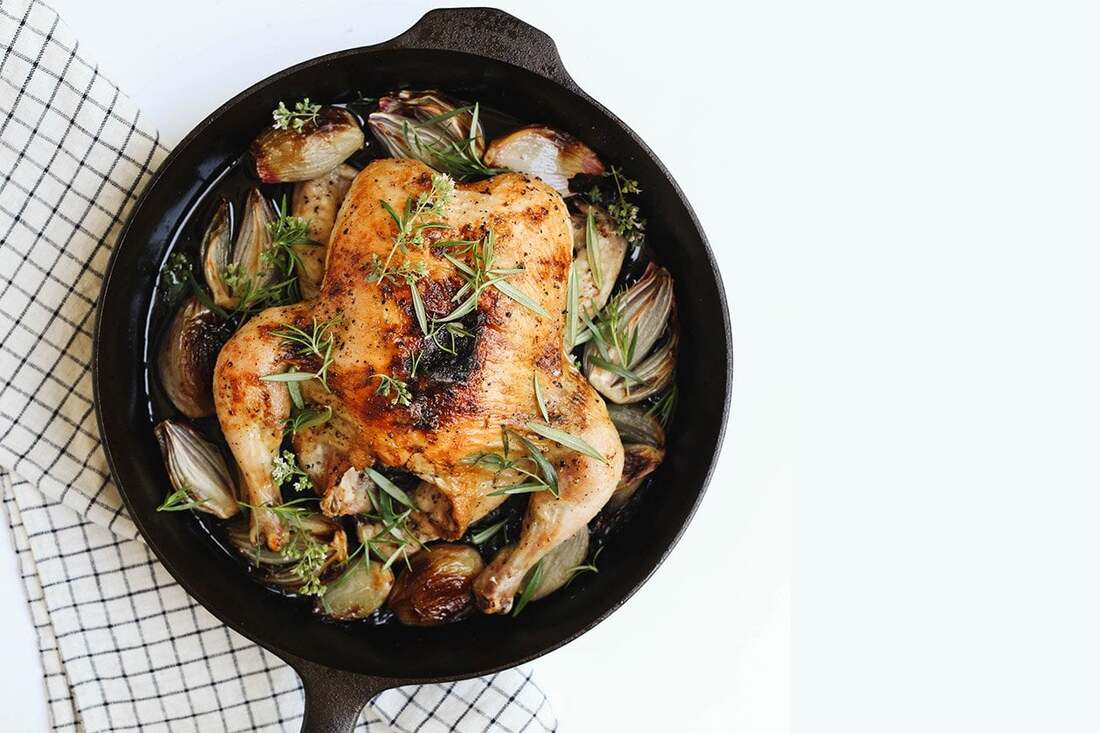|
by Bronwyn Gill, NTP
Hands down, one of the most important tools in a healthy kitchen is quality cookware. It’s a purchase that you’ll hopefully make once in a lifetime, yet we often go for what’s cheap and easy. Spoiler alert — nothing cheap or easy will ever benefit your pocketbook or health. Im going to cover the two types of cookware you’ll want to avoid, and which options are going to be the best long term investment for your kitchen and your body. The most popular, yet arguably the most toxic option people purchase is non-stick cookware with a plastic coating like Teflon. When Teflon is manufactured, a man-made chemical called Perfluorooctanoic acid (PFOA), also known as C8, is used in the process. PFOA is the most persistent synthetic chemical known to man and is found in the blood of nearly every person tested 1. Toxicologist Tim Kropp, Ph.D., a senior scientist with the Environmental Working Group, finds the situation alarming. He exclaims, “[PFOA] doesn't break down -- ever…It would take your body two decades to get rid of 95% of it, assuming you are not exposed to anymore. But you are.” Further, PFOA has been linked to birth defects, increased cancer rates, and changes to lipid levels, the immune system, and liver. It is likely a human carcinogen and it is highly persistent in the environment 2. The second cookware option you’ll want to avoid is aluminum. While aluminum is the most abundant metal in the earth's crust and occurs naturally in soil, water, and air, its use is also widespread among many consumer products. You can find aluminum used and distributed in cookware, antacids, astringents, buffered aspirin, food additives, antiperspirants, and cosmetics. Specifically, aluminum cookware has been shown to leach a significant amount of aluminum into food during cooking, which could pose a toxicity threat. In humans, high levels of aluminum in the body have been shown to cause brain and bone disease, while studies in animals have shown that the nervous system is a sensitive target of aluminum toxicity 3. The EWG has placed aluminum on their “watch list” due to its extensive use and the uncertainty surrounding this metal and its long term, cumulative health effects 4. For these reasons, avoiding aluminum exposure in your cookware is generally a good idea. Now that we’ve covered the two types of cookware to completely avoid, let’s move onto the two types of cookware you want to have in your kitchen. Oh, and if you’re wondering how to cook your morning omelet without major sticking…we’ll cover that too. Your first option is going to be stainless steel. Stainless steel is easy to maintain, heats up quickly and evenly, can be put in the oven, and will last a lifetime. If the financial commitment of a new stainless steel set is too steep, simply start by purchasing the pieces you use the most and build your perfectly curated collection overtime. The most common complaint with stainless steel cookware is the fact that foods stick. This could happen if you don’t have the proper technique! To ensure a perfect non-stick surface be sure to heat the pan first, add your healthy fat or oil, and then the food. With some practice, it’ll become quite easy, promise! The second option is cast iron. The first known use of cast iron cookware was during the Han Dynasty in China, around 220 A.D. Casting techniques became widespread in Europe by the 16th century, and since then, this versatile equipment has been a staple in households all over the world 5. Cast iron is non-stick, easy to clean, very inexpensive, basically indestructible, will last a lifetime, and is visually appealing. Well maintained cast iron can be passed down for generations making this not only healthy for you but a better way to create a healthy legacy in your family! Cast iron does require maintenance and care through proper “seasoning” to keep them rust-free and non-stick, but this process is quick and easy. Be sure to follow the manufacturer's guidance on how to do this! There we have it — the two pieces of cookware to avoid and the two to go out and purchase today! Happy cooking. 1. DeNoon, Daniel J. “Is Teflon Chemical Toxic? EPA Seeks Answers.” WebMD, WebMD, 13 Jan. 2005, www.webmd.com/cancer/news/20050113/is- teflon-chemical-toxic-epa-seeks-answers#1. 2. Ewg. “New Study and New Dangers of the Old Toxic Teflon Chemical.” EWG, www.ewg.org/enviroblog/2009/…/new-study-and-new-dangers-old- toxic-teflon-chemical. 3. “Toxic Substances Portal - Aluminum.” Centers for Disease Control and Prevention, Centers for Disease Control and Prevention, 21 Jan. 2015, www.atsdr.cdc.gov/phs/phs.asp?id=1076&tid=34. 4. “Food Additive ‘Watch List.’” EWG, www.ewg.org/research/ewg-s-dirty- dozen-guide-food-additives/food-additive-watch-list. 5. Bomberger, Sabrina. “The History and Resurgence of Cast Iron Cookware.” WebstaurantStore, WebstaurantStore, 6 July 2016, www.webstaurantstore.com/…/…/history-and-resurgence-of-cast- iron-cookware.html.
0 Comments
Your comment will be posted after it is approved.
Leave a Reply. |
Our BlogRead here for more information about our practice, industry news, tips for taking care of your body, and great recipes for healthy living. Categories
All
|


 RSS Feed
RSS Feed